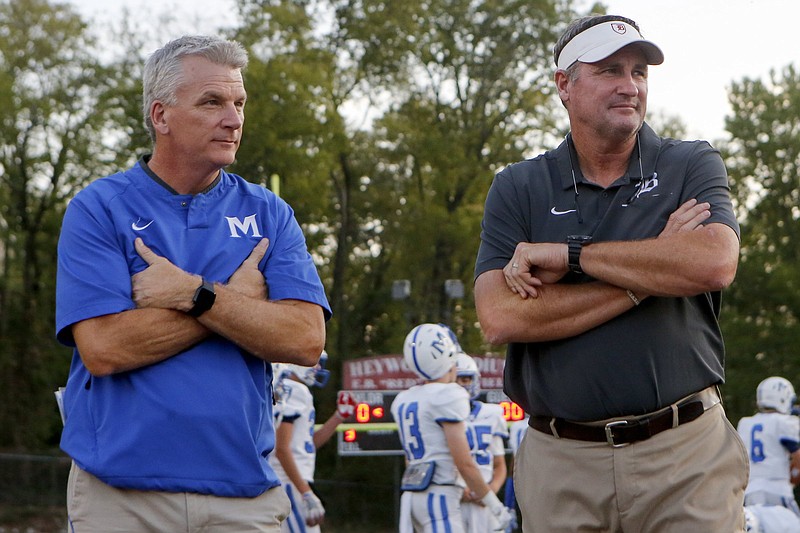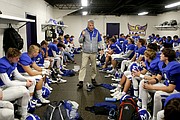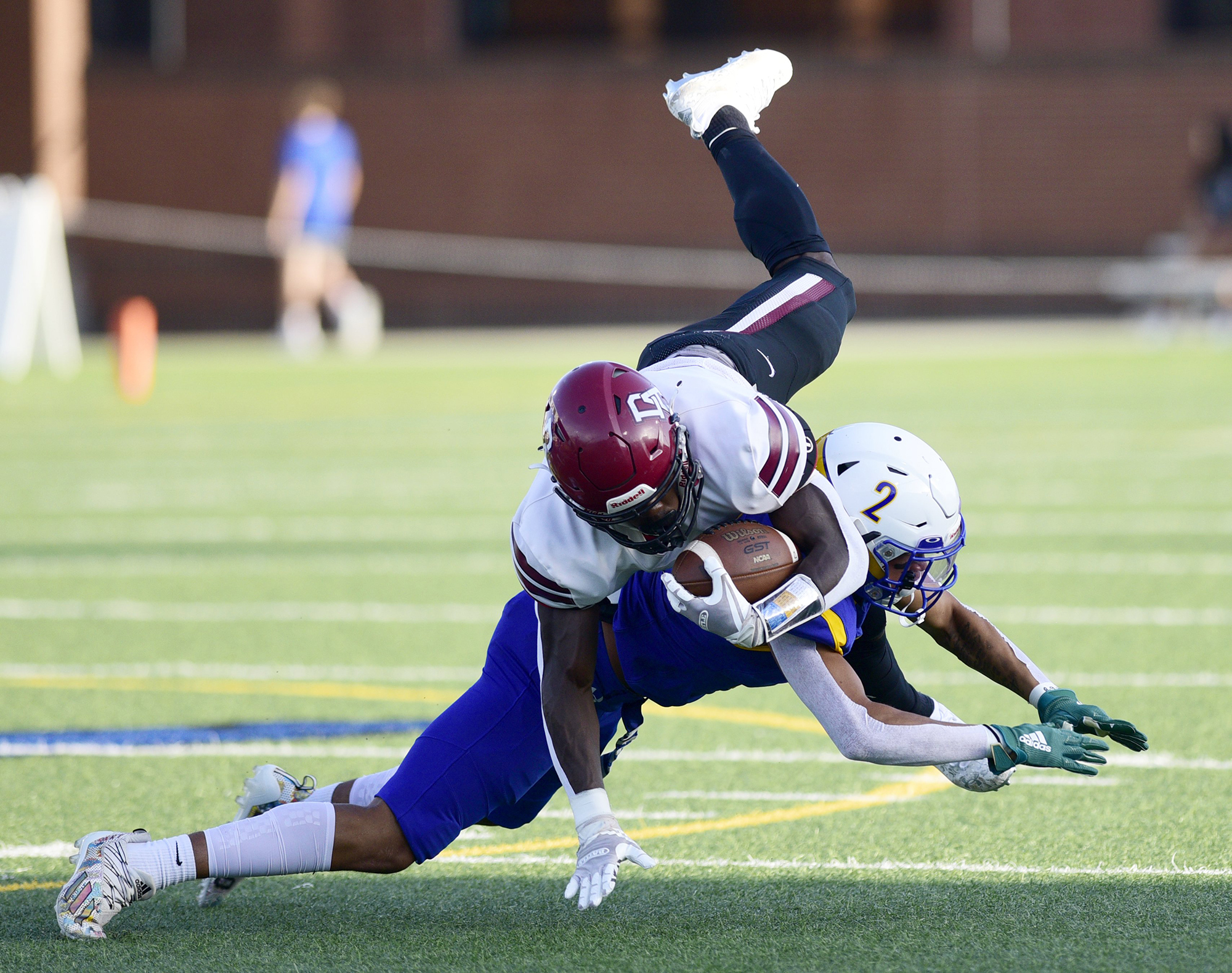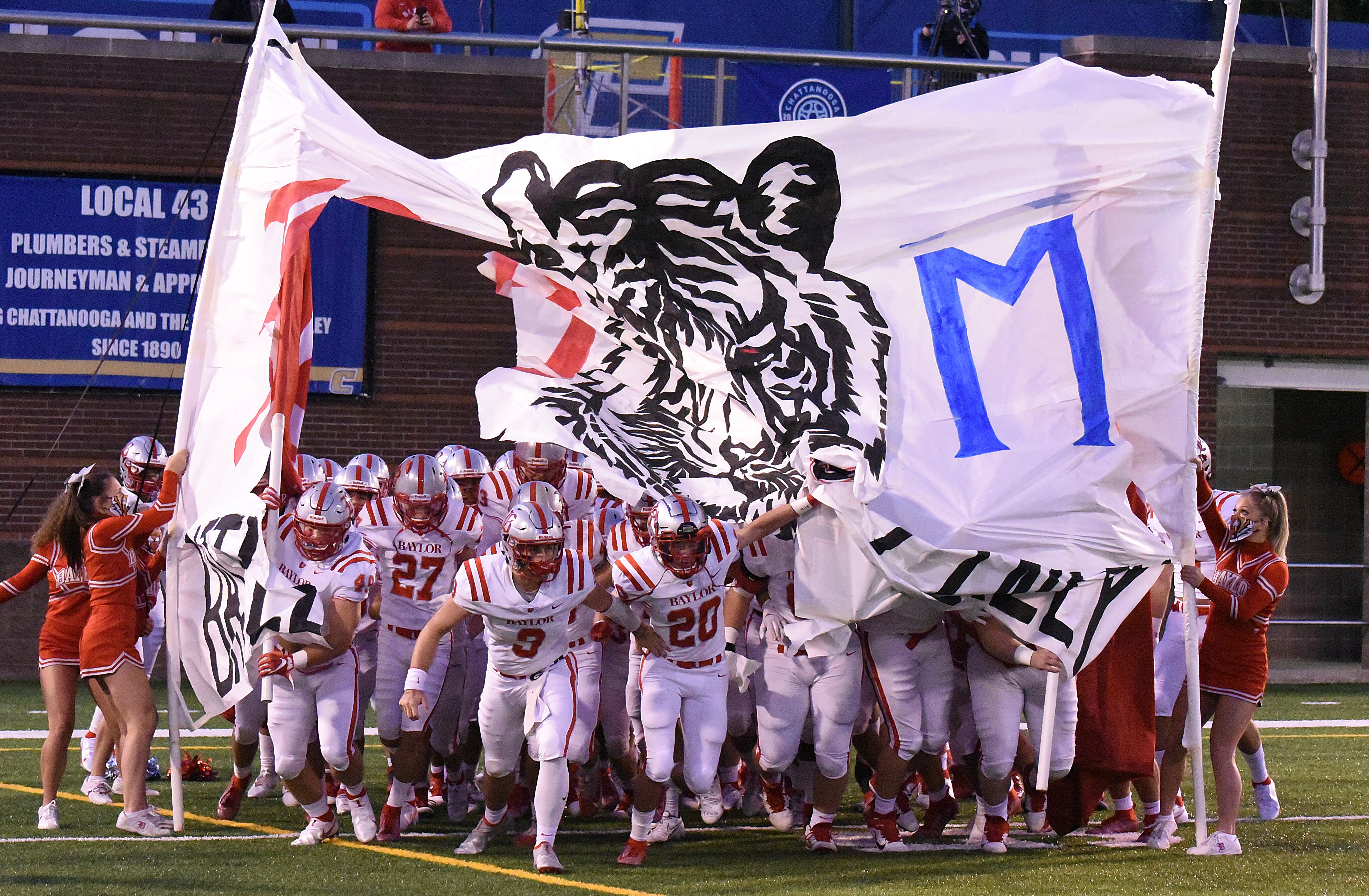For more BlueCross Bowl coverage from the Times Free Press, read more here.
The sleet and frigid December wind blowing across Vanderbilt's Dudley Field set a dramatic backdrop for the culmination of an icy situation in Tennessee high school sports that had grown colder by the year.
In the final moments of Brentwood Academy's convincing win over perennial state power Murfreesboro Riverdale for the 1995 Class 5A football championship, Ronnie Carter - the TSSAA executive director at the time - began walking toward the press box elevator on his way to make the on-field trophy presentation. As Carter stood waiting for the elevator doors to open, a voice from the Riverdale coaches' box yelled in his direction, "Private schools are 3-0!"
"I knew that was coming," Carter said as he buttoned his overcoat.
Despite an enrollment that would have allowed Brentwood Academy to compete in 2A, its coaches chose to play up three classifications to compete in what was then the state's highest level. The Eagles still dominated their way to an undefeated season among the schools with bigger enrollments, outscoring 15 opponents by an average of more than 30 points, including a double-digit win to dethrone Riverdale - the previous season's champion - in Nashville.
BA's win also was the third title for private schools in the five classes, each by double figures. That moment served as a catalyst for the end of a unified high school sports membership in the state. Public school administrators saw it as the exclamation point on an argument they had waged for decades: Their teams could no longer compete against private schools for championships.
Just four months after the private schools' domination in those 1995 football title games, the TSSAA's Legislative Council - which is responsible for statewide rules changes - voted 6-1 in favor of creating a separate league for schools that give financial aid to athletes. One year after the vote, the new rule was implemented and this fall serves as the 25th anniversary of that first season of the split in competition between Division I (public schools) and D-II (private schools) in the Tennessee Secondary School Athletic Association.
"There was no doubt in anybody's mind at the state office that we were totally against the split," said current TSSAA executive director Bernard Childress, who was an assistant director at the time of the split. "We felt it was discriminatory against a small portion of our membership. Young people don't care who they play, they just want to compete against their friends.
"The bottom line is it was all about winning and winning championships. Every rule change, whether it's public-private or any other, is always about winning championships. It's all about gold ball trophies."
Thursday’s TSSAA BlueCross Bowl at Finley Stadium
Division II-AACPA (11-2) vs. Lipscomb Academy (11-1), 11 a.m.Division II-ADCA (11-1) vs. Nashville Christian (11-2), 3 p.m.Division II-AAAMcCallie (12-0) vs. MBA (9-3), 7 p.m.
DRIVEN BY FOOTBALL
Prior to the split, by the fall of 1995, private schools had won 17 consecutive state championships in boys' tennis, 11 straight in boys' golf and nine in wrestling in a 12-year span. But because that domination had come in the so-called "minor sports" - those that do not generate as much revenue - the real resentment remained under the surface for most public schools.
Former Riverdale principal Hulon Watson, who had a background coaching football at Hargrave Military Academy in Virginia, began researching the differences between the state's public and private schools in the mid-1990s. He learned that while private schools made up just 15% of the TSSAA membership, they were winning nearly 60% of the championships in the state's 13 sanctioned sports.
"Football was what got everybody's attention," Childress said. "Once the private schools began to win big in football, that was the tipping point. That stirred up enough frustration that the public school coaches and administrators came together to find a way to move the private schools out of their way when it came to competing for championships."
As was the case with the TSSAA's original rule to separate schools by enrollment, which created a classification system in 1969, football was at the heart of the decision that changed the landscape of prep sports and made Tennessee the first state to divide all high school athletics along public and private lines.
Accusations of recruiting were the basis for the public schools' argument that a competitive imbalance was growing with their private school counterparts. Athletic success at a championship level largely requires talented athletes, and according to public school coaches, the ability of the private schools to use their considerable resources to recruit across any school zone meant they could collect the top athletes in any area, then use those players to beat public schools and contend for championships.
"If another program comes in and takes away any of your best players, it will make it tougher to win games, especially against the better competition," Meigs County coach Jason Fitzgerald said. "When coaching is your livelihood, you know you have to win games or else you could lose your job. A lot of us took that very serious when a private school would come in and recruit a kid out of your middle school or off our varsity."
REAL SEPARATION
The original split 25 years ago created Division II and two classifications within it: Small and Large, which was referred to at the time as the "Super Seven" because it was a league of only seven large schools from across the state: Baylor, Brentwood Academy, Christian Brothers, Father Ryan, McCallie, Montgomery Bell Academy and Memphis University School.
Since that first season of divided competition, the competitive gap has only widened between public schools and the programs in D-II.
"Our league has grown so much in terms of the level of competition since the split, and honestly it's like a small college league in terms of how we go about running our programs now," said McCallie coach Ralph Potter, the only current head coach who has continued in D-II since its inception.
"College coaches know there will be four to five guys per team (in TSSAA D-II) that will sign with FCS programs or higher every year," Potter added.
When the Blue Tornado played Brentwood Academy in the 2006 state title game for DII-AAA, only two of the combined 44 starters on both teams did not later play college football at some level.
Since the split, Baylor is 42-6 overall against Chattanooga-area public schools, with its most recent loss to such competition coming against Soddy-Daisy in 1999. Only twice during their current 41-game winning streak versus area public schools have the Red Raiders won by fewer than double digits.
Meanwhile, McCallie is 30-5 against area public schools since the split, having won eight straight - all by 35-plus points - with its most recent loss coming to McMinn County in 2012. Only five of those 30 wins were by fewer than double digits.
That disparity has caused more and more area public schools to simply refuse to schedule either Baylor or McCallie, leaving those two programs to search other states to find willing opponents.
THE BIG DIFFERENCE
Phil Massey was the head coach at Class 4A Haywood County when the split was implemented and was hired to take over the Baylor program in 2006. He said when he arrived at Baylor, there was a striking and immediate difference between coaching at a public and private school.
"The big thing is the resources," said Massey, who has won 105 games with the Red Raiders. "You don't have to go out and do fundraising like we did with a public school program, where money for even things like new equipment is usually a concern. In public school it seemed like a marathon every season just in terms of having to coach both sides of the ball, teaching four classes a day and then do things like field maintenance, wash the uniforms and arranging the details like transportation and food for road trips.
"The other noticeable difference is the size of the coaching staffs. At Haywood, I had myself and three assistants, but here I've got nine assistants plus a full-time strength coach. Having that many coaches has really raised the strategic level. When the split happened, the competitiveness from the private schools being forced to play each other made everyone raise their level of play to a very high standard across the board."
Although initially the TSSAA allowed private schools that chose not to give financial aid to continue competing in the public school division, the enrollments of those schools were multiplied by 1.8 to force them to play up in classification. Most of the smaller to mid-sized private schools - including area programs Boyd Buchanan, Chattanooga Christian, Grace Academy, Notre Dame and Silverdale Baptist Academy - opted to discontinue giving financial aid to athletes and remain in the public school division.
Eventually even that concession was not enough, and by a majority vote in 2018, it was decided to move all private schools into Division II. There are now three D-II classifications for football, while the public schools compete in six classes.
"In the end it has worked out best for everybody, but that's because we have made sure the D-II kids receive everything the public school teams have in terms of state tournaments and championships," Childress said. "But it's still amazing to me that high school kids now don't even realize there was a time when public and private schools played in the same division."
Contact Stephen Hargis at shargis@timesfreepress.com or 423-757-6293. Follow him on Twitter @StephenHargis.



